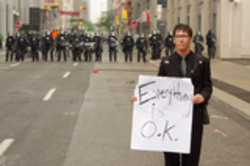G20 'secret law' to undergo independent review
A so-called “secret law” widely criticized for giving police excessive powers during June’s G20 summit protests and riots will be the subject of an independent review, The Star has learned.
Government sources said Tuesday that former Ontario chief justice Roy McMurtry has agreed to lead the examination of the 1939 Public Works Protection Act, passed to deal with home front security risks during the Second World War.
The move follows repeated calls for the law’s modernization in the wake of the G20, which saw thousands of protesters take to the streets and small bands of vandals torch police cars and smash store windows. Police arrested 1,105 people and charged 278. The rest were released or never booked. Most charges have been subsequently dropped.

At issue is widespread misinterpretation of a “five-metre rule,” under which authorities fuelled the belief that anyone coming within five metres of the outer security fence snaking through downtown Toronto could be required to provide identification or submit to a search.
Civil libertarians complain that impression emboldened police and had a chilling effect on the rights of citizens to free expression and association.
“We need to make sure our laws reflect the security concerns and values of our society today,” said Community Safety and Corrections Minister Jim Bradley, who will announce the review Wednesday.
“That includes maintaining both public order and freedom of expression.”
McMurtry, an attorney general and solicitor general in the 1970s and 1980s under premier Bill Davis, will look at the scope of authority given to police and requirements for public notice of regulations made under the act, how it applies to major events, and what constitutes a “public work” under the law.
It was a regulation under the act, quietly rubber-stamped by Premier Dalton McGuinty’s cabinet early last June, that designated areas within the downtown G20 security zone as a “public work.” Misunderstandings over the significance of the regulation catapulted the Ontario government and Toronto Police Chief Bill Blair into controversy.
McGuinty’s cabinet made the temporary change at Blair’s request.
The chief wanted clarification for officers if they had to apprehend anyone inside the restricted area, including the Metro Toronto Convention Centre and Royal York hotel where world leaders met June 26-27.
The Star first revealed the unusual modification June 25, three days before it was to expire and eight days before it was published in the Ontario Gazette.
In the wake of that story, the prevailing, incorrect impression was that police had been given the power to arrest people who refused to provide identification or submit to a search within five metres of the security zone’s outer perimeter.
But Blair, McGuinty and then-community safety minister Rick Bartolucci, who defended the “extraordinary” powers during the G20 summit, didn’t set the record straight until two days after the event ended.
Blair admitted there was no five-metre rule, saying, “No, but I was trying to keep the criminals out.”
Bartolucci was replaced by Bradley in a recent cabinet shuffle, taking Bradley’s former post as minister of municipal affairs and housing in a sign of McGuinty’s displeasure over the fiasco.
“There was no five-metre rule. It was constantly published in print and republished on TV and radio and there was no foundation in fact for that,” McGuinty later acknowledged. “And we should have acted on that sooner to make it clear.”
The regulation was published on the specialized provincial legislation website known as e-Laws on June 16, more than a week before the G20. But the site is not well known, meaning the regulation was not adequately publicized.
“When passing regulations under this act, we have to make sure we provide the public with proper information and notice,” a senior government official said Tuesday.
McMurtry is expected to report next spring after consulting with lawyers, police, civil liberties groups and others.
He will also consider recommendations from Ontario Ombudsman Andre Marin’s previously announced review of the act and take into account the Toronto Police Services Board investigation of the G20 command structure and policing model. The province’s Special Investigations Unit is also probing five alleged incidents of police brutality against protesters.
A number of the more than 60 complaints to the ombudsman’s office were critical of the government for confusing the public in the way the policy change was “communicated or not communicated or miscommunicated,” Marin said when he launched his probe in July.
“What our complainants are telling us is the way it was explained and sold to the public as the ‘five-metre rule’ led to contravention of their constitutional rights to freedom of expression and association…it had a chilling effect.”
“The other thing they’re telling us is it had a misguided effect on the law enforcement around the fence and that it led to liberties by law-enforcement officials and how they reacted to demonstrators within those five metres,” Marin added.
The review by McMurtry will help the government, which faces a provincial election on Oct. 6, 2011, develop a foundation for future legislation, sources said.
Both McGuinty and Prime Minister Stephen Harper have ruled out holding public inquiries into the handling of security at the summit.
Source: http://www.thestar.com/news/canada/article/864561--g20-secret-law-to-undergo-independent-review



